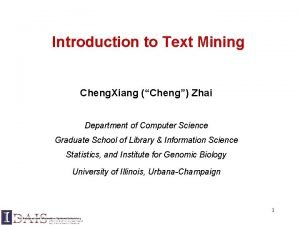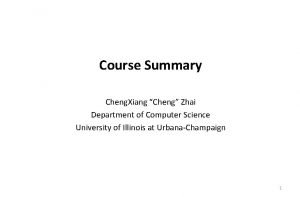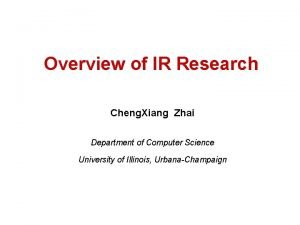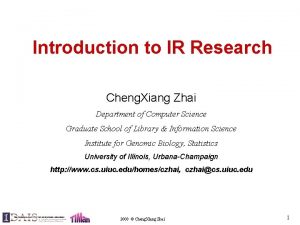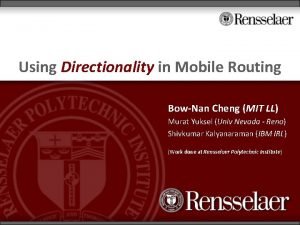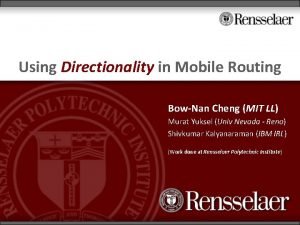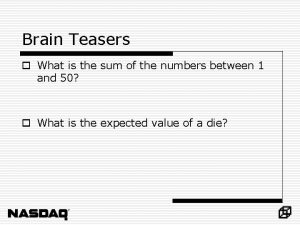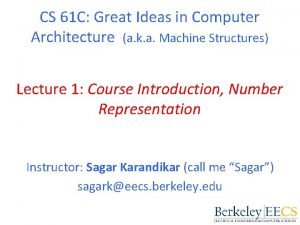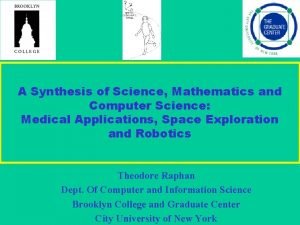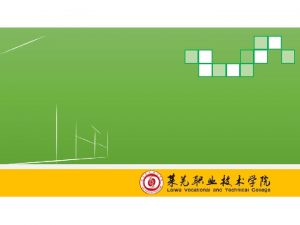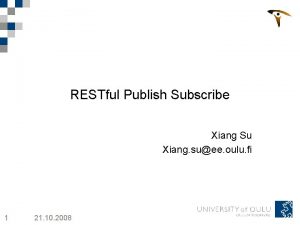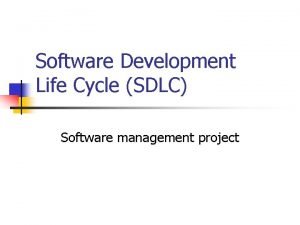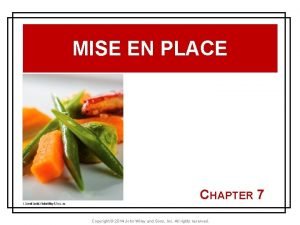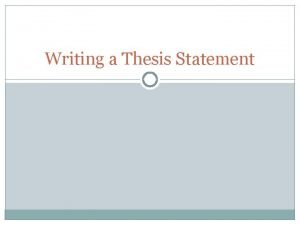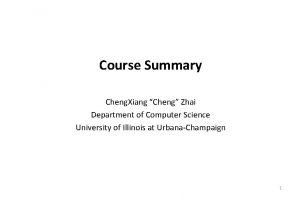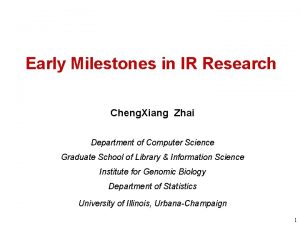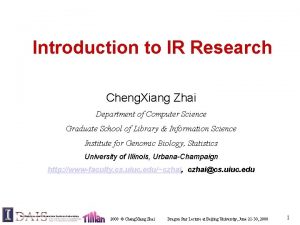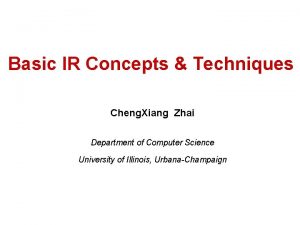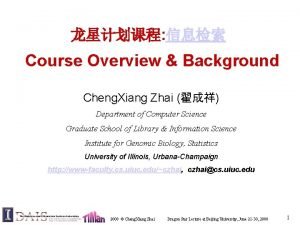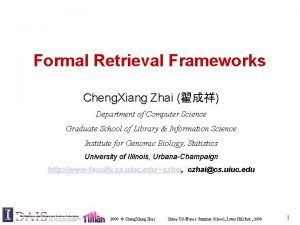Preliminary Research on Research Cheng Xiang Cheng Zhai




























- Slides: 28

Preliminary Research on Research Cheng. Xiang (“Cheng”) Zhai Department of Computer Science Graduate School of Library & Information Science Institute for Genomic Biology, Statistics University of Illinois, Urbana-Champaign http: //www-faculty. cs. uiuc. edu/~czhai, czhai@cs. uiuc. edu 2014 ADC Ph. D School in Big Data, The University of Queensland, Brisbane, Australia, July 13, 2014 1

What is Research? • • Research – Discover new knowledge – Seek answers to questions Basic research – Goal: Expand man’s knowledge (e. g. , which genes control social behavior of honey bees? ) – Often driven by curiosity (but not always) – High impact examples: relativity theory, DNA, … Applied research – Goal: Improve human condition (i. e. , improve the wolrd) (e. g. , how to cure cancers? ) – Driven by practical needs – High impact examples: computers, transistors, vaccinations, … The boundary is vague; distinction isn’t important 2

Why Research? Curiosity Amount of knowledge Basic Research Utility of Advancement of Applications Technology Applied Research Quality of Life Application Development 3

Where’s Your Position? Different position benefits from different collaborators Amount of knowledge Basic Research Utility of Advancement of Applications Technology Applied Research Quality of Life Application Development 4

Thoughts on Impact • Impact (Q, A)=Importance. Of. Problem(Q)*Qualityof. Solution(A) – Quality. Of. Answer(A): [0, 100/100], thus – Impact(Q, A) <=Importance. Of. Problem(Q) • Interactive impact: – Make Impact(P 1, …, Pk) >=Impact(P 1)+…+Impact(Pk) – This is possible if P 1, …, Pk form a coherent story (together they enable something bigger) • Suggestions: – Think big maximize Importance. Of. Problem – Solve synergistic problems maximize interactive impact – Strive for BEST solution maximize Qualityof. Solution 5

Discovery-Impact Tradeoff Disocvery of knowleedge (# citations) Goal Impact on society (# users; $$$) 6

What is a Good Research Problem? • Well-defined: Would we be able to tell whether we’ve solved the problem? • Highly important: Who would care about the solution to the problem? What would happen if we don’t solve the problem? • Solvable: Is there any clue about how to solve it? Do you have a baseline approach? Do you have the needed resources? • Matching your strength: Are you at a good position to solve the problem? 7

How to Find a Problem? • Application-driven (Find a nail, then make a hammer) – Identify a need by people/users that cannot be satisfied well currently (“complaints” about current data/information management systems? ) – How difficult is it to solve the problem? • No big technical challenges: do a startup • Lots of big challenges: write a research proposal – Identify one technical challenge as your topic – Formulate/frame the problem appropriately so that you can solve it • Aim at a completely new application/function (find a high-stake nail) 8

How to Find a Problem? (cont. ) • Tool-driven (Hold a hammer, and look for a nail) – Choose your favorite state-of-the-art tools • Ideally, you have a “secret weapon” • Otherwise, bring tools from area X to area Y – Look around for possible applications – Find a novel application that seems to match your tools – How difficult is it to use your tools to solve the problem? • No big technical challenges: do a startup • Lots of big challenges: write a research proposal • – Identify one technical challenge as your topic – Formulate/frame the problem appropriately so that you can solve it Aim at important extension of the tool (find an unexpected application and use the best hammer) 9

How to Find a Problem? (cont. ) • In practice, you do both in various kinds of ways – You talk to people in application domains and identify new “nails” – You take courses and read books to acquire new “hammers” – You check out related areas for both new “nails” and new “hammers” – You read visionary papers and the “future work” sections of research papers, and then take a problem from there –… 10

General Steps to Define a Research Problem • Generate and Test: Raise a question and do the following tests • Novelty test: How novel is the question? You want to maximize novelty • • – Ideally, the question has never been studied in the existing literature – If it has been studied, what’s the reason for further studying the question? Can you identify any COMMON deficiency of ALL existing work addressing the problem? • Yes: your research problem is how to address the identified common deficiency • No: it’s not a compelling research problem (but can you make the question more challenging? ) Importance/Impact test: How important is the question? What’s the expected impact? – Why do we need to address this question? What if we don’t address this question? – How would the world benefit from addressing this question? Who will benefit from it? – Aim to address a “big pain” or at least a “real pain” Every time you reframe a problem, try to do all the tests again. 11

What It Takes to Do Research • Curiosity: allow you to ask questions • Critical thinking: allow you to challenge assumptions • Learning: take you to the frontier of knowledge • Persistence: so that you don’t give up • Respect data and truth: ensure your research is solid • Communication: allow you to publish your work • … 12

Critical Thinking • • Develop a habit of asking questions, especially why questions Always try to make sense of what you have read/heard; don’t let any question pass by Get used to challenging everything Practical advice – Question every claim made in a paper or a talk (can you argue the other way? ) – Try to write two opposite reviews of a paper (one mainly to argue for accepting the paper and the other for rejecting it) – Force yourself to challenge one point in every talk that you attend and raise a question 13

Respect Data and Truth • Be honest with the experiment results – Don’t throw away negative results! – Try to learn from negative results • • Don’t twist data to fit your hypothesis; instead, let the hypothesis choose data Be objective in data analysis and interpretation; don’t mislead readers Aim at understanding/explanation instead of just good results Be careful not to over-generalize (for both good and bad results); you may be far from the truth 14

Communications • General communication skills: – Oral and written – Formal and informal – Talk to people with different level of backgrounds • Be clear, concise, accurate, and adaptive (elaborate with examples, summarize by abstraction) • English proficiency • Get used to talking to people from different fields 15

Persistence • Work only on topics that you are passionate about • Work only on hypotheses that you believe in • Don’t draw negative conclusions prematurely and give up easily – positive results may be hidden in negative results – In many cases, negative results don’t completely reject a hypothesis • Be comfortable with criticisms about your work (learn from negative reviews of a rejected paper) • Think of possibilities of repositioning a work 16

Optimize Your Training • Know your strengths and weaknesses – strong in math vs. strong in system development – creative vs. thorough –… • Train yourself to fix weaknesses • Find strategic partners • Position yourself to take advantage of your strengths 17

Optimizing “Research Return”: Pick a Problem Best for Your Passion High (Potential) Impact Your Strength Best problems for you Find your passion: If you can choose any job in the world, what would you do? Test of impact: If you are given $1 M to fund a research project, what would you fund? Find your strength/Avoid your weakness: What are you (not) good at? 18

Typical Structure of a Research Paper • 1. Introduction – – • Background discussion to motivate your problem Define your problem Argue why it’s important to solve the problem Identify knowledge gap in existing work or point out deficiency of existing answers/solutions – Summarize your contributions – Briefly mention potential impact Tips: – Start with sentences understandable to almost everyone – Tell the story at a high-level so that the entire introduction is understandable to people with no/little technical background in the topic – Use examples if possible 19

Typical Structure of a Research Paper (cont. ) • 2. Previous/Related work – Sometimes this part is included in the introduction or appears later – Previous work = work that you extend (readers must be familiar with it to understand your contribution) • – Related work = work related to your work (readers can until later in the paper to know about it) Tips: – Make sure not to miss important related work – Always safer to include more related work – Discuss the existing work and its connection to your work • Your work extends … • Your work is similar to … but differs in that … • Your work represents an alternative way of … – Whenever possible, explicitly discuss your contribution in the context of existing work 20

Typical Structure of a Research Paper (cont. ) • 3. Problem definition/formulation – Clearly define your problem • If it’s a new problem, discuss its relation to existing related problems • If it’s an old problem, cite the previous work – Justify why you define the problem in this way – Discuss challenges in solving the problem • Tips: – Give both an informal description and a formal description if possible – Make sure that you mention any assumption you make when defining the problem (e. g. , your focus may be on studying the problem in certain conditions) 21

Typical Structure of a Research Paper (cont. ) • 4. Overview of the solution(s) (can be merged with the next part) – Give a high-level information description of the proposed solutions or solutions you study • – Use examples if possible 5. Specific components of your solution(s) – Be precise (formal description helps) • – Use intuitive descriptions to help people understand it Tips: – make sure that you organize this part so that it’s understandable to people with various backgrounds – Don’t just throw in formulas; include high-level intuitive descriptions whenever possible 22

Typical Structure of a Research Paper (cont. ) • 6. Experiment design: make sure you justify it – Data set – Measures – Experiment procedure • Tips: – Given enough details so that people can reproduce your experiments – Discuss limitation/bias if any, and discuss its potential influence on your study 23

Typical Structure of a Research Paper (cont. ) • 7. Result analysis: – Organized based on research questions to be answered or hypotheses tested – Be comprehensive, but focus on the major conclusions – Include “standard” components • • • Baseline comparison Individual component analysis Parameter sensitivity analysis Individual query analysis Significance test – Discuss the influence of any bias or limitation Tips – Don’t leave any question unanswered (try to provide an explanation for all the observed results) – Discuss your findings in the context of existing work if possible • Similar observations have also been made in … • This is in contrast to … observed in … One explanation is …. 24

Typical Structure of a Research Paper (cont. ) • 8. Conclusions and future work – Summarize your contributions – Discuss its potential impact – Discuss its limitation and point out directions for future work • 9. References 25

Tips on Polishing your Paper • • • Start with the core messages you want to convey in the paper and expand your paper by following the core story Try to convey the core messages at different levels so that people with different knowledge background can all get them Try to write a review of your paper yourself, commenting on its originality, technical soundness, significance, evaluation, etc, and then revise the paper if needed Check out reviewer’s instructions, e. g. , the following: http: //nips 07. stanford. edu/nips 07 reviewers. html (not necessarily matching your conference, but should share a lot of common requirements) Try to polish English as much as you can 26

After You Get Reviews Back • Carefully classify comments into: – Unreasonable comments (e. g. , misunderstanding): • Try to improve the clarity of your writing – Reasonable comments • • • Constructive: easy to implement • Non-constructive: think about it, either argue the other way or mention weakness of your work in the paper If paper is accepted – Take the last chance to polish the paper as much as you can – You’ll regret if later you discover an inaccurate statement or a typo in your published paper If paper is rejected – Digest comments and try to improve the research work and the paper – Run more experiments if necessary – Don’t try to please reviewers (the next reviewer might say something opposite); instead use your own judgments and use their comments to help improve your judgments – Reposition the paper if necessary (again, don’t reposition it just because a reviewer rejected your original positioning) 27

Summary • • Research is about discovery and increase our knowledge (innovation & understanding) Intellectual curiosity and critical thinking are extremely important Work on important problems that you are passionate about Aim at becoming a top expert on one topic area – Obtain complete knowledge about the literature on the topic (read all the important papers and monitor the progress) – Write a survey if appropriate – Publish one or more high-quality papers on the topic • Don’t give up! 28
 Cheng xiang zhai
Cheng xiang zhai Cheng zhai
Cheng zhai Cheng xiang zhai
Cheng xiang zhai Cheng xiang zhai
Cheng xiang zhai Cheng xiang zhai
Cheng xiang zhai Cheng xiang zhai
Cheng xiang zhai 鹅鹅鹅poem
鹅鹅鹅poem Routing table
Routing table Xiang cheng mit
Xiang cheng mit Seth zhai
Seth zhai Molly zhai
Molly zhai Preliminary research
Preliminary research Liu xiang
Liu xiang Record producer job description
Record producer job description Yongqing xiang
Yongqing xiang Its rosewhatt
Its rosewhatt Pu tao you
Pu tao you Vex xiang
Vex xiang Xiang yang liu
Xiang yang liu Perfume xia xiang
Perfume xia xiang Liu xiang weightlifter
Liu xiang weightlifter Xiang su
Xiang su Vex xiang
Vex xiang Xiang yu liu bang
Xiang yu liu bang Preliminary investigation in sdlc
Preliminary investigation in sdlc Preliminary cooking and flavoring
Preliminary cooking and flavoring Preliminary survey
Preliminary survey Preliminary marketing plan
Preliminary marketing plan Preliminary thesis
Preliminary thesis
